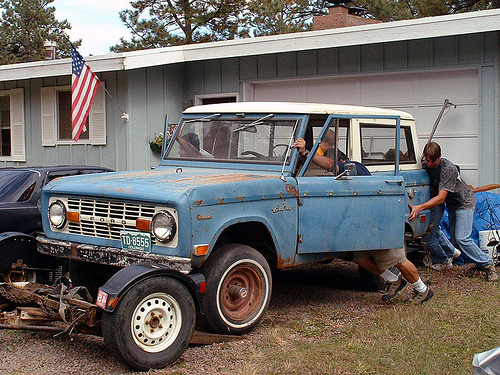You’ve spent months scouting for the perfect project car, you’ve negotiated with the owner, and taken care of the proper paperwork with your local motor vehicle department; now it’s time to tow your project car to its new home.
The car may be buried under 30 years of junk in the backyard of its former owner or parked in the front driveway. Each situation offers unique issues that may not present themselves until the job is underway, so it’s important to be prepared to ensure a stress-free and a safe journey.
Make sure you have the proper materials
If your new project is in a tough to maneuver location, it may be necessary to pull it to a safer, more accessible place before you load it on the trailer. Tow straps, work gloves, and a tool-kit are all must-haves to make sure you safely maneuver the project car to a secure location.
Bring a friend
Arrange to have at least one friend accompany you on your journey. You’ll need someone to help dig the car out of its former resting place, pull it to a safe place for extraction, back up the trailer, and unload the car when it arrives home.
Use the correct tow vehicle
If your tow vehicle is an SUV, make sure it’s equipped with a full hard top. Also, make sure the tow vehicle has fully operational lights and is outfitted with a wiring harness that connects to the trailer. If the wiring pattern on your trailer does not match the wiring pattern on your tow vehicle, an adapter is available that will match any pattern without the need to replace the harness. External mirrors on both the driver’s and passenger’s side of the vehicle are also a necessity.
Use the correct ball mount
Have the right hitch ball. The trailer you chose may fit on your current hitch ball; however, keep in mind that different trailers require specific weight capacities, so please contact your trailer rental company, or consult this guide to learn how to check the rating of your hitch ball.
Use the correct trailer
If you’re towing a front wheel drive car that is in good condition, you may want to use a tow dolly. If so, you must ensure the tow vehicle weighs at least 750 pounds more than the vehicle being towed. (It’s possible to tow a rear wheel drive car on a tow dolly; however, the drive shaft must be disconnected before the tow. Click here to learn more about using a tow dolly.
If your new project is a rear wheel drive, or in questionable condition, an auto transport trailer that allows the vehicle to be fully loaded without contact with the asphalt is your best choice for a trailer. The tow vehicle must weigh at least 3,500 lbs. (curb weight), and must equal or exceed 80% of the combined weight of the trailer and the vehicle being towed. Click here to learn more about using an auto transport trailer.
Information regarding the weight of your vehicle and it’s towing capacity can be found in the owners manual and/or the data plate in the driver’s door jamb.
If you are unsure of the type of trailer necessary to haul your project car, call your trailer rental location, or consult this guide for more information.
Be safe!
Be sure to check and make sure your project car is secure on the trailer, and the trailer is properly connected to the tow vehicle both before you depart, and at regular intervals on your journey.
Good luck, and don’t forget the duct tape!
Do you have any tips to help fellow car enthusiasts load their new project car and keep it safe on the journey home? Share your knowledge in the comment section below!
(flickr: oddharmonic/via cc)




